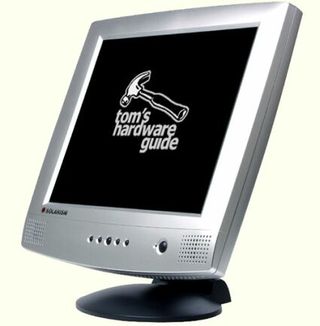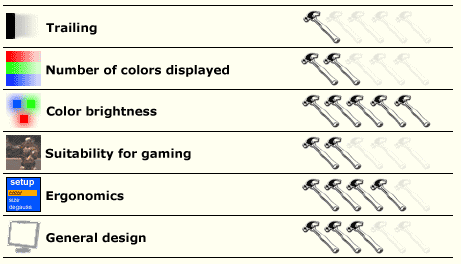17" LCD Part I: Six Sexy Panels
Solarism LM1711

Although the brand is only distributed in North America, China, and Russia, Solarism is already synonymous with top quality, even in Europe. The LM1711 was sent to us direct from the United States. After a few weeks of testing, we became depressed at the fact that we can't buy these screens over here. Test verdict: the reputation for excellence of these screens is not exaggerated.
Solarism produces monitors stamped ABT, the acronym for Advance Brightness Technology. What this means is that Solarism has borrowed a classic panel from a manufacturer and has developed and adapted its own system for it, one that redefines back-lighting and brightness. Hence this outstanding feature. The brightness of the LM1711 is 600 cd/m². In practice, colors are brighter and more attractive than those of its competitors. For the moment, it is impossible to say more about this special technology. Solarism is rather reticent on the subject and it's easy to understand why.
On the other hand, despite its exceptional features, the tests revealed a few surprises...
| Color | Darkest color displayed | Palest color displayed |
|---|---|---|
| Gray pattern | 5 | 254 |
| Red pattern | 10 | 254 |
| Green pattern | 5 | 254 |
| Blue pattern | 15 | 234 |
The pale shades are usually very well displayed. The very darkest cannot be distinguished and the panel used has significant gaps in the blues. Yet the colors in the games are much more attractive than in competing screens, even the Philips. Although the shades are not as numerous, they are much brighter and more faithfully rendered, because it is not simply a matter of displaying a large number of colors, they have to be displayed correctly. On this point, Solarism greatly outdoes its rivals. This is particularly obvious in games involving strong contrasts, such as Tropico or Dungeon Siege. None of the other five screens we tested did as well as this one.
The story is, unfortunately, very different in the case of shooting games such as Quake III and its derivatives. The response time is palpably slow. Although it claims to be 40 ms, the panel is clearly much less reactive than the five others tested. After checking with the manufacturers, it became clear that the panel used by Solarism is made by Samsung, and is mostly of the IPS type, a technology that is not known for its responsiveness. In practice, the 40 ms translates into a strong wake or trail, sometimes accompanied by brief breaks in the image during very fast movements. The screen is disappointing if it is the first LCD you have seen. The effect is much more unfortunate if one realizes how far the technology has progressed in terms of response time, and how far it will continue to progress, especially with ViewSonic's introduction of two monitors with response times of less than 20 ms. On the other hand, the images are, once again, far more attractive than those displayed on the Compaq, CTX, ADI and other LCD monitors.
The ABT is also most useful in office applications. The second button from the extreme left on the front makes it possible to switch through four pre-recorded levels of brightness. The screen can thus be adapted to the prevailing lighting conditions and the feature soon proves to be indispensable. Once again, there is no LCD screen to beat the LM1711. It offers incomparable ease of use.
Hats off to Solarism! Despite the fact that the total number of "hammers" awarded add up to fewer than those given to the Philips screen, the LM1711 is the screen that we recommend. That is unfortunate for us, because it isn't available in Europe. Unless they mean "not YET available"...
Stay on the Cutting Edge
Join the experts who read Tom's Hardware for the inside track on enthusiast PC tech news — and have for over 25 years. We'll send breaking news and in-depth reviews of CPUs, GPUs, AI, maker hardware and more straight to your inbox.

Most Popular

